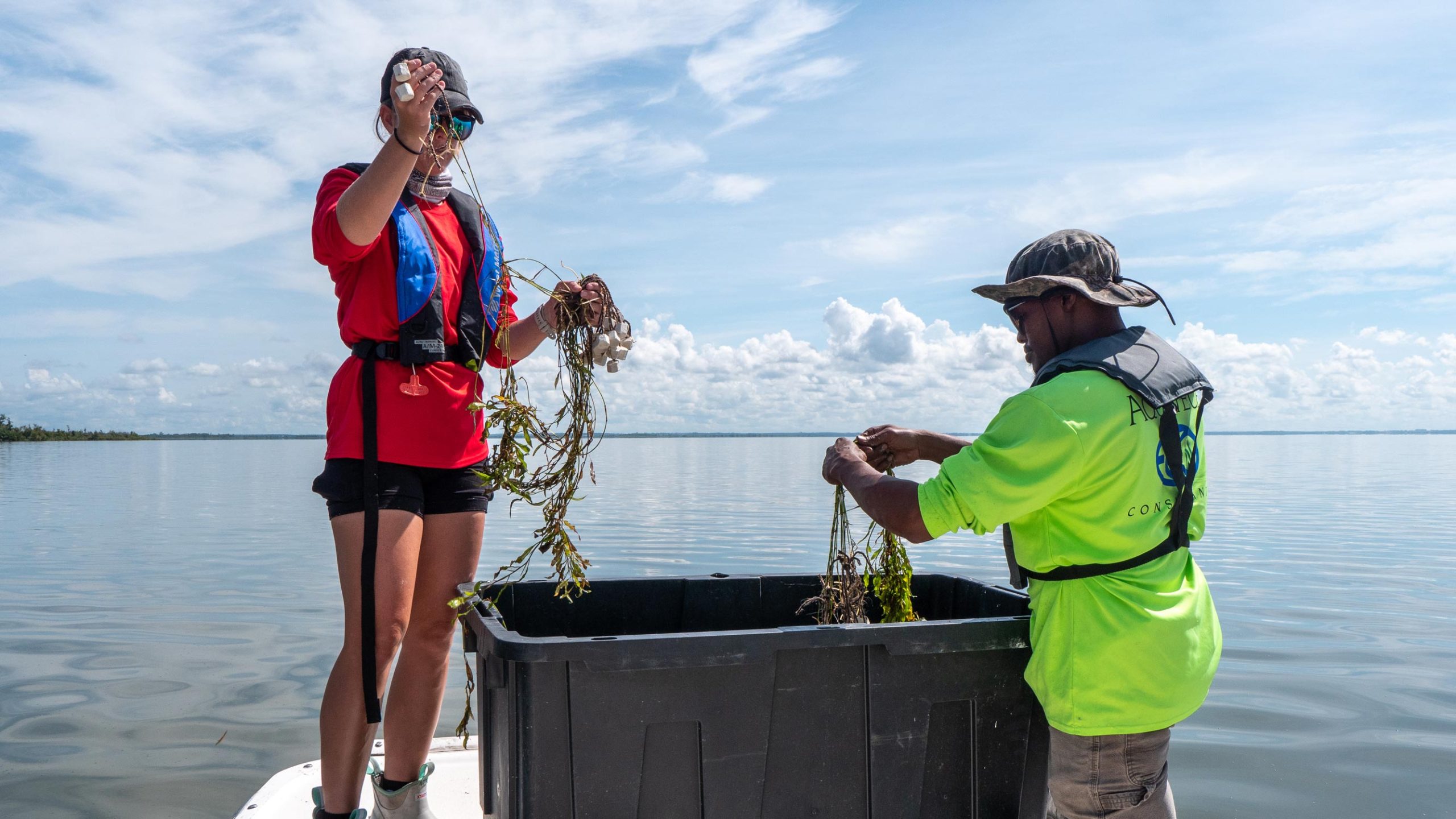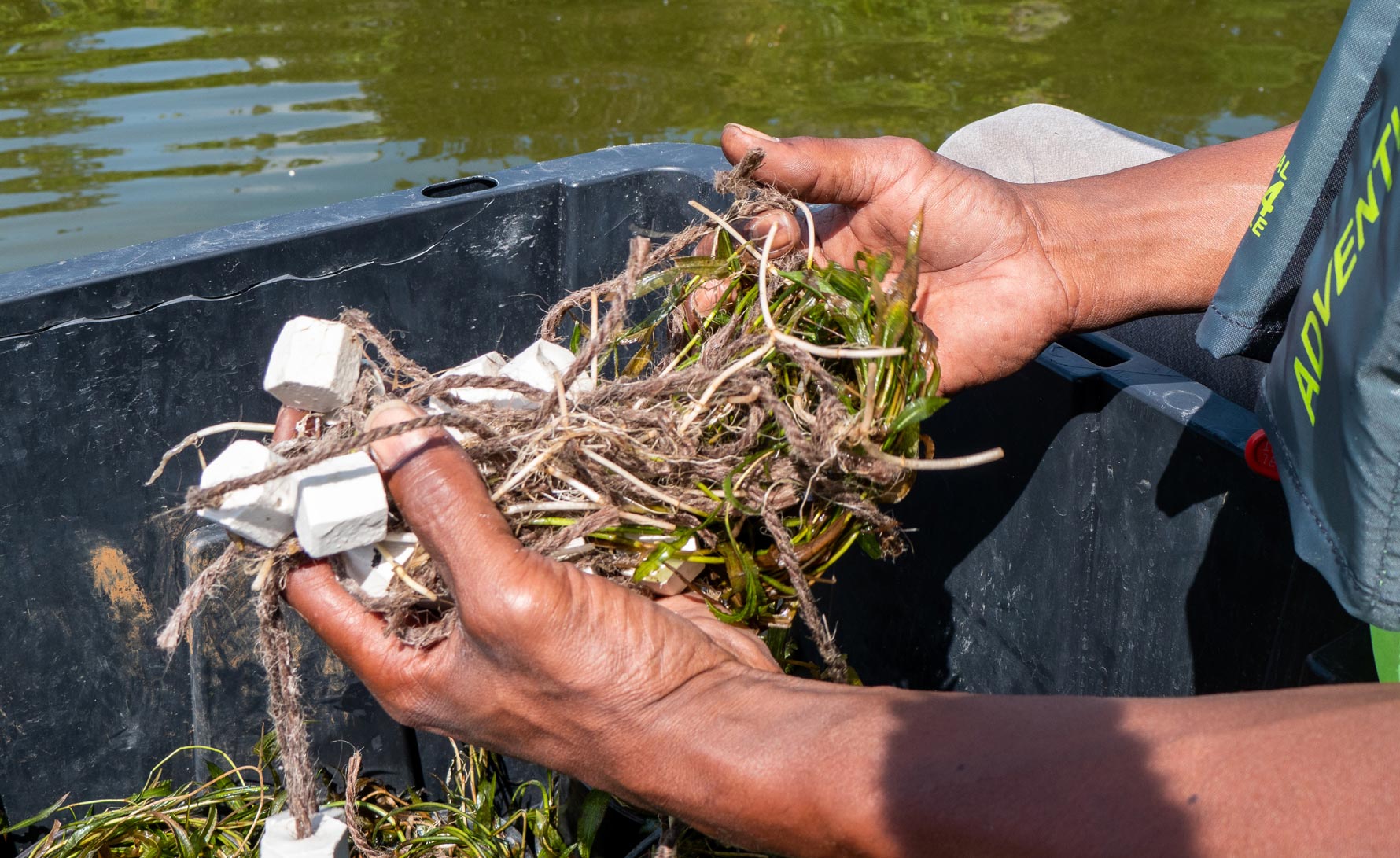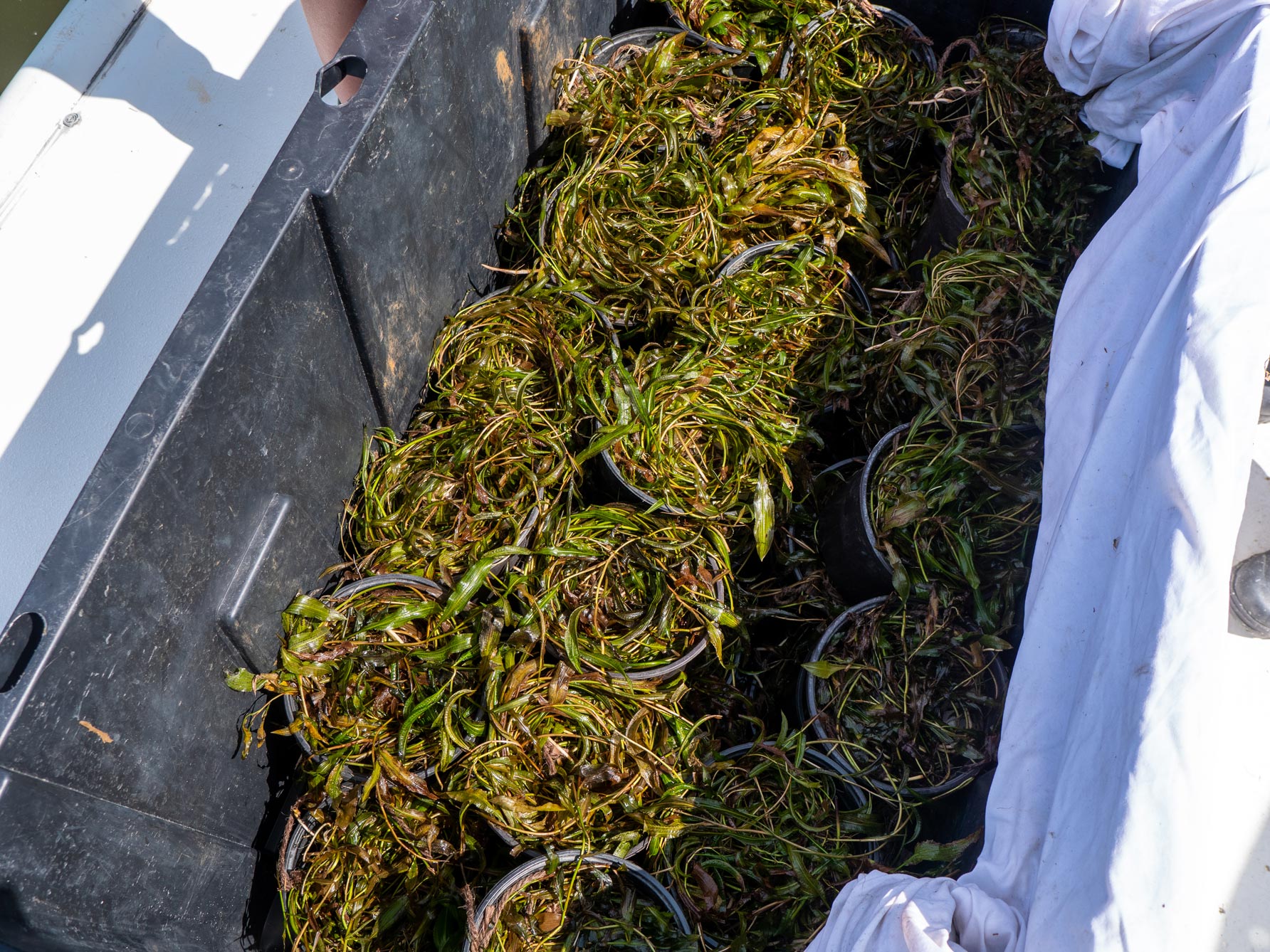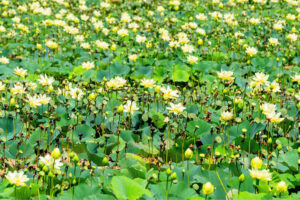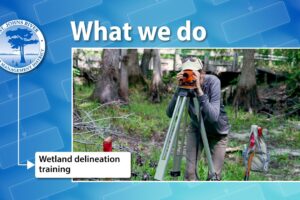The next stage of Lake Apopka’s restoration is underwater
Nov. 17, 2022
Under contract with the District, AquaTech Eco Consultants employees Nicole Jackson and Shawn Smith unpack and untangle native plants as part of a project to help re-establish Illinois pondweed, Potamogeton illinoensis, in Lake Apopka as part of the lake’s restoration.
The skiff barely makes a ripple in the shallow water along the edge of Lake Apopka as it slowly loops back and forth. Without a breeze, the water mirrors the sky, and the lake looks as blue as it once was. The boat circles erratically as it gradually winds along the lake’s edge. It seems random, but it’s one step in the systematic efforts to restore Lake Apopka.
The boat carries 6,000 plants – all Illinois pondweed, Potamogeton illinoensis, affectionately called “pote” by Jodi Slater, an Environmental Scientist with the St. Johns River Water Management District. Potamogeton is a native plant found in waterways in Florida and throughout North America.
“Potamogeton is a species found in healthy lakes,” explains Slater. “To see Potamogeton become established and start reproducing in Lake Apopka is another indication that the water quality is improving.”
Pondweed used to be dominant in Lake Apopka but disappeared 70 years ago. With District efforts to prevent pollution and restore the lake, other aquatic plants returned naturally. “It’s hard to say why pondweed didn’t naturally come back; it may have just exhausted its seed bank,” Slater says. Now that water quality has improved to the point that Potamogeton will survive, Slater hopes that re-establishing populations along the shoreline will provide a durable, steady source of seeds.
To help re-establish the pondweed, a team of District scientists selected 48 acres, shallow sections at the edges of the lake where the plants can get enough sunlight to survive. The District worked with a contractor, AquaTech Eco Consultants, to grow and plant Potamogeton, as well as another native lake plant, eelgrass (Vallisneria americana).
AquaTech employees, Nicole Jackson and Shawn Smith, patiently unpack and untangle each long, stringy Potamogeton plant, then delicately toss them into the water. They sink to the bottom, visible only if it reaches the top few inches of the lake surface. The day before, Jackson and Smith carefully tied a bio-degradable plaster weight to each plant (to anchor the seedling in place until the roots take over the job) and gently packed all 6,000 plants into plastic tubs. Josh Menendez pilots the boat, consulting his GPS unit as he weaves back and forth within each acre-sized plot while Slater checks the plants as well as maps.
The boat stirs up dark sediment clouds in the shallow water as it circles. It’s called floc, and it’s a legacy of years of algal blooms. “It’s mostly dead algae that doesn’t have any place to go, so it just kind of falls out, settling on the lake bottom,” explains Slater. Floc is the main reason Lake Apopka looks brown and murky. Winds and storms stir up the floc and it becomes resuspended in the water column, limiting how much light can reach the bottom of the lake.
Turn back the clock to the 1930s, and Lake Apopka was crystalline. The lake is spring-fed, and underwater plants like eelgrass, naiad, coontail and Illinois pondweed proliferated in the clear water – even in the deepest part of the lake. This diverse aquatic ecosystem provided habitat and shelter where crustaceans and small fish could hide, growing larger and larger. Lake Apopka was known as a place to catch trophy bass. Dozens of fish camps dotted the lake edge, and movie stars traveled to central Florida to pull lunkers from the lake, central Florida’s original tourist attraction.
Farming began in the area after the 1890s construction of the Apopka-Beauclair Canal, that lowered water levels by a third. The new canal allowed citrus to be more easily transported to markets. Then, 50 years later, with encouragement from the federal government, farmers expanded their fields by building dikes and pumping out water, expanding fields even farther. In the 1940s a levee was built to isolate about 20,000 acres of the lake’s floodplain from the lake. Farmers planted and tilled the rich organic soil, working to pull carrots, cabbage and lettuce from the former marsh that bordered the lake. By 1941, farmland covered some 20,000 acres of former marsh, mainly on the north shore.
Transforming the landscape from wetlands to farmland meant that the excess nutrients from fertilizers and drained rich soils now went directly into the lake. Add to that, the processing plants and lakeside communities that discharged effluent into the lake, amplifying pollution. The water quality in Florida’s second largest lake was getting worse and it was happening fast.
In 1946, the aquatic plants that covered the lakebed began to die. Widespread algal blooms triggered by excess nutrients became more and more frequent. As the algae died it became floc, and the water became cloudier and cloudier. By 1950, the pondweed and the rest of the underwater plants were gone. Game fish populations crashed, then the fishermen left and ultimately the fish camps disappeared as well.
By the mid-1970s, farmers, citrus processors and utilities began steps toward reducing pollutant inputs and some restoration efforts began. In the late 1980s the District first purchased a portion of the floodplain farmland and began projects to improve the lake’s water quality. In the early 1990s the District and some of the farmers were implementing projects to lessen runoff from the farms. In 1995, small patches of the once abundant aquatic plant eelgrass, Vallisneria americana, began appearing spontaneously in the lake.
In 1996, under direction from the Florida Legislature, the District purchased 15,000 acres of north shore farmlands. This was a turning point in restoration efforts as it dramatically reduced the largest nutrient inputs and the District could now focus on removing pollution. By 2003, the District had completed construction of an engineered wetland system on a 760-acre section of the acquired land.
The Marsh Flow-way is a system of levees, canals and wetlands that acts like a kidney for lake water. Each year, about 30–40 percent of the lake’s volume moves through the flow-way, and wetland plants filter out algae, suspended floc and nutrients. The flow-way is incredibly effective: from opening to 2019, the system removed an average of 2.2 metric tons of phosphorus and 4.3 tons of suspended solids annually. As water quality and clarity improve, these rates predictably declined.
It’s not the only cleanup effort. A District project harvesting gizzard shad from the lake has also removed phosphorus from the lake. Gizzard shad are a native fish, common in nutrient-rich lakes and their feeding in the sediments accelerates nutrient cycling between floc sediments and lake water. Harvesting fish removes nutrients in their bodies and slows the nutrient recycling. But the purchase of the farms and restoration of wetlands on the former floodplain is by far the largest driver of water quality improvements. Water clarity has increased by 57%, phosphorus is 65% lower and chlorophyll-a (a measure of algae) has declined by 58% since the 1980s.
Following these water quality improvements, aquatic plants began to recover, re-establishing patches around the edges of the lake. Scientists knew that increasing the number of aquatic plants within the lake would accelerate the lake’s recovery. “If we plant more plants, the lake’s water quality improves faster by creating a biofeedback loop. Plants slow down water, so the floc and sediment drops out of the water column, making it clearer. Their roots help trap sediment in the lake bottom, keeping it from being resuspended. More light helps plants grow better and spread, consuming the nutrients that fuel algal blooms, helping to clear the water even more so light reaches deeper into the water column and plants can grow in deeper,” explains Slater. In 2020, the District began a project planting eelgrass and pondweed in Lake Apopka to help accelerate improvements in water quality.
Initially, the District worked with researchers at the University of Florida, experimenting with where and how to plant these submerged aquatic plants. Through this research, they came up with the idea of using eco-friendly plaster weights, as well as packing the plants’ roots and soil into burlap “burritos.” These two techniques save time and money and keeps contractors from being immersed in Lake Apopka water while planting.
The greatest challenge to getting these new plants established? “Hydrilla,” says Slater. This invasive aquatic plant lives in low light and has become established in most areas of Lake Apopka, including the lake edge where Slater and the consultants are currently planting. “If left unchecked, it can go bonkers.”
Hydrilla doesn’t offer the diversity of habitat, nor the water quality benefits of the native species. The Florida Fish and Wildlife Conservation Commission removes sections of hydrilla in anticipation of the District’s planting efforts. “Hopefully, these plants become established and can outcompete or shade out the hydrilla,” says Slater. “But we can’t just leave the hydrilla. It would create a monoculture.” Left unchecked, hydrilla’s growth can block canals and structures the District needs for its flood protection mission.
In several months Slater will return to check on the plantings. The aquatic planting project is in the second year and she is already seeing some successes: eelgrass planted last year is thriving, reaching the surface of the lake or “topping out” and flowering. The same is happening with the Potamogeton. “The goal is to get pote as a seed source to eventually repopulate the lake naturally,” she says.
It’s a step in what’s been a long journey to recovery for Lake Apopka.
To learn more about the District’s work to restore Lake Apopka, visit www.sjrwmd.com/lake-apopka.


